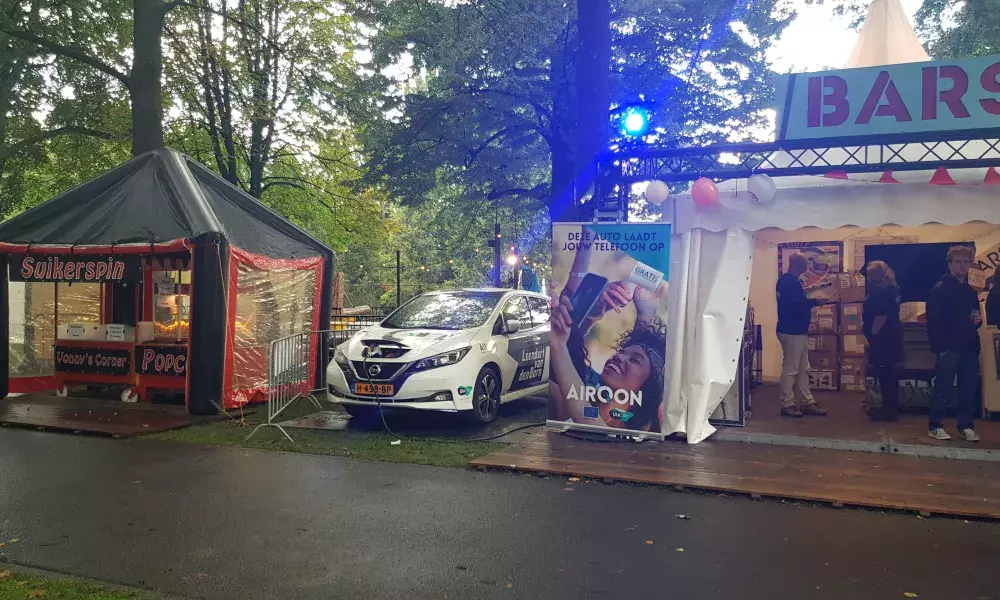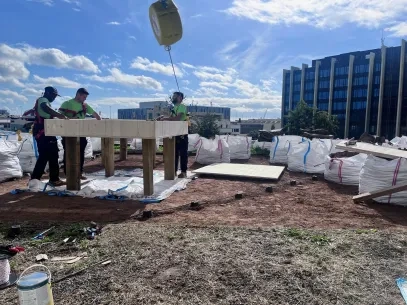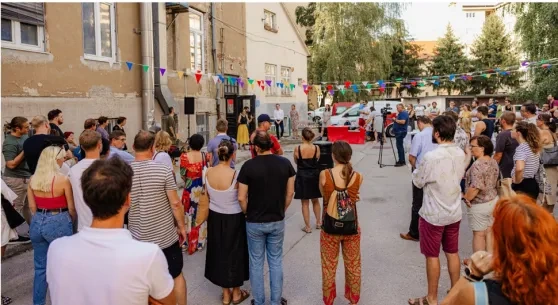Events before and after AIRQON; how well they work? The case of Breda Barst

Engagement, in an initiative like this, starts from the fact of being aware of a problem and believing in a solution. First of all, AirQon has started from the analysis of the public, the community, the potential participants, understanding their concerns and not directly assuming what their thoughts and believes are. Whether they are full electric mobility enthusiasts, or people who have nothing to do with this. In fact, this surveying exercise always give rise to new ideas that enrich engagement strategies. All this effort ultimately leads to the origination of the AirQon community, having that it is something new that must be created.
In addition to direct surveying, an important part of this project has been the monitoring and evaluation of emissions generated at events that traditionally opted for conventional solutions, such as diesel generator sets, and are now opting for sustainable alternatives like AirQon, batteries, and fixed-grid power supply points. Specifically, here we present the insights obtained from the air quality measurements conducted at the Breda Barst festival during its 2019 and 2022 editions. As will be seen below, this allows for a clear contrast of the beneficial effects on air quality experienced.
In an initiative like this, the involvement of event organizers is crucial, as is the participation of the electric car user community. However, we must not forget the key role played by energy provider companies, who can advise event organizers to take a definitive step forward or stick to conventional solutions
To better understand to what extent the public that attends events is aware of environmental challenges, and especially to know their willingness to become an active part of the solutions adopted to go for more sustainable cities, in 2021 more than 800 people were interviewed, especially regarding their impressions of the environmental issues and solutions AirQon addressed. This sample represented almost 5% of the public who attended Ploegendienst Festival 2021.
75.2% of people interviewed considered ‘important’ or ‘very important’ that an event organizer takes measures to organize it sustainably. The measure that generated the most consensus was using durable cup system, with 47.5% of the people agreeing on rating it as ‘very important’, closely followed by using pocket ashtrays. This fact really draws the attention because using them is an individual action in spite of being promoted by the event organizer. This shows how sustainability begins with oneself and represents, at the same time, a firm respect and awareness for the environment.

1 – very low; 2 – low; 3 – medium; 4 – high; 5 – very high (Source: Kairos Events)
They are followed in importance by limiting the amount of food and residual waste, limiting emissions of harmful substances in relation to personal health, reducing CO2 emissions and undertaking measures to reduce air pollution by replacing diesel generators with electricity. 25% of respondents highlighted the latter kind of actions, since they can contribute to greener events by switching to power sources like electricity distribution network supplies, battery packs and, of course, electric cars.
So, it can be stated that attendees notice the impact of sustainable actions undertaken at local level. Hence, people going to an event perceive the externalities and negative effects that AIRQON intends to mitigate or even avoid. Asked about the nuisance of dust, soot and smoke, smoking visitors were listed first by the interviewed attendees, followed by diesel generators, food trucks or food courts, and campfires. Therefore, people resulted to be concerned with the environment without too much direct nuisance of these sources.

Awareness and personal commitment are therefore a reality. And that involvement is a very positive factor for the success of AirQon as a sustainable power solution: 90.6% of interviewed people would not be bothered if they were asked for some efforts in terms of sustainability as attendees.
This research on engagement has been also complemented by the Breda digipanel in the year 2021, surveying a total of 2,245 residents of the city. For them, the most relevant initiatives were those aimed at limiting emissions harmful to people's health –this is very important for 54.4% and important for 28.2% of them–, followed by those measures oriented to reduce waste –very important for 53.3% and important for 33.3%– and to reduce harmful emissions to the environment in general –very important for 50.2% and important for 28.7%–. Two other types of measures, aimed at reducing noise pollution and odor nuisance, do not reach the same consideration for those people surveyed, although they were considered very important or important for 71.1% and 62.5%, respectively.
In addition to this, deep diving into actions that event organizers can carry out in particular, the one that gathers the most consensus is avoiding the use of plastics and replacing it with sustainable materials –very important for 59.8% of those citizens surveyed–, followed by the substitution of diesel generators for electricity provided from the distribution network –very important for 39.5% of the people. In this survey it was highlighted the importance of replacing generators by AirQon, so events use energy from electric vehicle batteries: this was considered very important or important for 62.1% of respondents.
Consequently, mobility, which can be fully considered as a service, is in full evolution towards these new sustainable applications to power events, homes, businesses, etc. thanks to the latest advances in technical performance of electric vehicles combined with an innovative solution like AirQon. This is a greener, more efficient model that contributes to air quality improvement in our cities and fits perfectly into the new models based on sharing, flexibility and versatility.
A key element of the measurement strategy is that we measure concentrations in the air, which is directly relevant for humans who spend time in the vicinity of the generators, such as visitors of events and workers. This is not identical to emissions which describe how much pollution is emitted in the air by generators
Utrecht University, by means of IRAS, Institute for Risk Assessment Sciences, a partner of AirQon project, led measurement campaigns, which were performed with research-grade, accurate real-time monitors. This specific instrumentation was carried in standard backpacks by research staff, as well as GPS devices to provide accurate geographical position, so every concentration measurement is accompanied by its exact location. This brings added value, for instance, by allowing to correlate measurements and distance to pollutant emissions sources.

Nevertheless, it must be noted that assessing the impact of diesel generators at events is complicated because air quality levels of these relevant pollutants are also affected by background pollution from other sources such as industry, road traffic or weather conditions. In addition to this, other combustion sources may be present, such as smoking visitors or food courts.
As in the case of living lab measurement campaigns held outdoors on the premises of the Utrecht University in October 2020, the main air pollutants emitted by diesel generators were considered: fine particles (specifically PM2.5, particles smaller than 2.5 micrometer), soot (carbon particles from incomplete combustion of fuel), and ultrafine Particles (UFP, particles smaller than 100 nanometer).

After calibration of the instruments in the Utrecht University IRAS Laboratory, assembling them into the backpacks, and perform on site final checks… We are ready to start! Research staff backpackers move around the event monitoring a wide variety of situations in a repetitive, cyclic way: close to the generators, some distance away of them, nearby food trucks and food courts, etc. At the beginning of the measurement campaign, and every hour along the monitoring period, research staff carrying backpacks must meet at the so-called control area. This location, which is far from pollutant sources, is considered to have the background conditions that let compare pollutant concentration measurements and GPS data of all the backpack kits.

Breda Barst is one of the most important events in Breda, with more than 25 editions held. It is formed by spread areas: several stages, market, food courts, kids’ area, etc. Breda Barst 2019 measurements were made on September 14th, along a period of 5 hours, while the festival was in full operation. The control area was close to the venue entrance, away from the festival area, and without relevant pollutant local sources such as diesel generators or heavy-traffic roads. In this edition, Breda Barst ran powered by three diesel generators, distributed over the festival areas, varying from 15 to 125 kVA nominal power.

For all three pollutants, soot, fine particles (PM2.5) and ultrafine Particles (UFP), clearly higher concentrations were measured near the generators. As displayed in Table 1, the relative difference between measurements made near the generator and the control area are far greater than those made around festival area and the control area. In particular, up to a 1,500% increase was evidenced for soot, that may be caused by a very low baseline concentration measured at the control area; PM2.5 increased up to a 250%; and finally, UFP rose around 70%. Concentrations measured in the festival area also increased significantly, due to the presence of pollutant sources such as food courts and the relative proximity to diesel generators, located at multiple locations, thereby affecting a larger area of the festival.
|
Pollutant |
Festival area – Control |
Generators – Control |
|---|---|---|
|
BC-UV |
1184 % |
1537 % |
|
PM2.5 |
173.7 % |
258.8 % |
|
UFP |
45.7 % |
69.5 % |
These increases are also depicted in the following box plots. These graphs group values between 25th and 75th percentile within boxes, which are considered as the most representative set of values experienced. The median is represented by a line inside the box, dividing half of the measurements below and the other half above. Furthermore, these representations also display individual, extreme values measured along the measurement campaigns.



Similarly, the following box plots represent air pollutant concentrations, but the measurements are aggregated based on different distances from diesel generators. It is important to note that, for each measurement, the distance to the closest generator was considered.


The measurements for Breda Barst 2022 were taken on September 16th, during a period of 3 hours when the event was in full operation. The event was held at the Valkenberg Park, the same location as the 2019 edition, in the heart of the city of Breda. Similar to 2019, the event was powered by three 250 kVA diesel generators.
However, in 2022, a new sustainable approach was implemented, resulting in a new energy configuration. Specifically, the first diesel generator set served as a backup system for a battery pack and a fixed-grid power supply point. In the event of a complete failure of the battery pack, the generator would activate.
So, what were the results of this configuration? Throughout the event, the main stage and nearby stands required a total of 400 kWh of electricity. Out of this, 300 kWh were consumed from the battery pack, 100 kWh were sourced from the electricity distribution network, and interestingly, the backup diesel generator set was not used at all during the entire event.

Considering that the access to the electricity distribution network in the event area is limited to a few points of delivery, with a constrained capability, it is not feasible to power all energy demands solely from these points. Additionally, the distances between the event areas and the supply points could be significant, making it challenging to ensure a secure and stable energy supply.
To address these challenges, the second and third diesel generators were configured similarly. Each generator was equipped with its own battery pack, allowing the generators to activate only when the capacity of their respective storage unit was low. Once the battery pack was charged, the generators remained powered off until a new need arose. Consequently, pollutant emission measurements were taken during periods when the diesel generators were both on and off during the event, regardless of their operating status. Furthermore, an AirQon bidirectional device was used to provide energy for specific stands and a bike parking service.
The research staff, equipped with measurement backpacks, conducted three rounds of measurements. During each round, they simultaneously measured the air quality near the three generators. They then split up to walk around the festival area before returning to the control area. It is important to note that the control area for the 2022 edition was different from the one in 2019, as the latter was not accessible.
The results obtained clearly demonstrated a significant difference depending on the operational status of the diesel generators. Higher concentrations were observed near the generators, particularly when they were turned on. As shown in Table 2, there was a substantial increase in soot and UFP emissions, with approximately a 700% and 225% rise, respectively, compared to the measurements in the control area. However, the increase in pollutants was almost imperceptible when the generators were turned off, except for PM2.5. The increase in PM2.5 was observed under both operating regimes of the diesel generators and could potentially be attributed to other factors, such as wind carrying pollutants from greater distances.
|
Pollutant |
Diesel generators status |
Festival area - Control |
Generators - Control |
|---|---|---|---|
|
BC-UV |
ON |
154.9 % |
688.2 % |
|
UFP |
ON |
83.1 % |
226.3 % |
|
PM2.5 |
ON |
110.9 % |
18.9 % |
|
BC-UV |
OFF |
154.9 % |
6.25 % |
|
UFP |
OFF |
83.1 % |
-6.1 % |
|
PM2.5 |
OFF |
110.9 % |
-10.7 % |
The following figures show the measurements taken for the three pollutants near the generators, depending on whether the generator was on or off. These figures reveal a substantial difference in pollutant levels. It is worth noting that when the generators were off, no significant differences were found between the measurements taken at the generator and control areas. The pollutant levels were only slightly higher in the festival area.
This pattern is significantly different from what was observed during Breda Barst 2019, where much higher concentrations were measured near the generators throughout the entire event. However, it is important to consider that the measurements may include contributions from other air pollution sources or emissions generated during periods when the generators were turned on.



The following box plots represent air pollutant concentrations aggregated based on different distances from the diesel generators, where no clear pattern was observed with respect to the distance from the generator. This is consistent with the generators being turned off for a significant portion of the event. Consequently, it became more challenging to distinguish generator emissions from other sources of pollutants.


During festival days, the neighbors in the vicinity are more aware, and the annoyance caused by the operation of diesel generators can be lower. However, during the days prior to and following the event, during the setup and dismantling, there are occasionally more complaints. Therefore, the use of alternative solutions such as AirQon and battery packs remains particularly relevant.
Before deploying an energy solution, an assessment must be made in two dimensions. On the one hand, regarding power. All customers at events traditionally tend to oversize their demanded power, trying to ensure that there is never a shortage. But, obviously, the necessary power must be determined wisely, as when buying a car and choosing the size of its engine. This must be a rational decision, with a well-balanced technical-economic commitment. Also, it must be noted, as previously indicated, that the power output has direct implications with the performance of the diesel generator: the closer to its nominal power, the better performance in its operation, in addition to less emissions. It is then evident how environmentally impacting is the use of over-sized diesel generators in the days before and after the event. Those days they are under particularly inefficient regimes, due to the low demand being fed during short periods in contrast to the higher, more stable demand during the event itself.
On the other hand, the energy needed throughout the whole event must be considered. This has direct implications with the duration of the event and, ultimately, with the resulting environmental impact of it as well; for instance, a badly sized diesel generator could be running a few hours… or a few days. These considerations must be done in the same way that the energy needs of a home are decisive to design a vehicle-to-home solution, or the working hours in an office for a vehicle-to-building one.
Measurements of air quality at different festivals, such as the cases of Breda Barst 2019 and 2022 detailed here, have documented significant increases in air pollution at short distances from the diesel generators. However, Breda Barst, thanks to good energy planning, has a slightly lower effect due to the distribution of diesel generators throughout the festival area instead of being heavily concentrated in a single location. In any case, the largest increases were observed for soot and ultrafine particles, while moderate increases were found for fine particles. Furthermore, the impact of the generators can be detected up to 150 meters from the generator locations.
Measurements near the generators within a 10-meter radius showed significantly higher increases in concentration compared to measurements near major roads in the Netherlands, encompassing all pollutants, including PM2.5. These findings highlight the substantial exposure risk posed by air pollution emissions from generators at events. Previous research has consistently shown that soot, UFP, and PM2.5 have health implications even at lower concentrations. Therefore, reducing the use of diesel generators will play a crucial role in improving population health.
Furthermore, observations revealed a sharp decline in concentration as distance from the source increased, indicating that staff and volunteers working backstage are particularly vulnerable to high levels of exposure. In contrast, due to the location of the generators at both festivals, visitor exposure was relatively moderate. It is also noted a moderate increase in pollution across the entire festival area, which could be attributed not only to generator emissions but also to factors such as smoking and food preparation. Moreover, the absolute concentration values measured were influenced by the atmospheric conditions during the monitoring period. In most cases, the measurements were taken under relatively unstable atmospheric conditions, suggesting that the findings obtained likely provide a conservative estimate of the generators' impact on air quality.
In short, this measurement assessment underscores the need for alternative solutions, such as AirQon and battery packs, to reduce the use of diesel generators, and even avoid them, and mitigate the associated health risks. By doing so, we can create healthier environments for event attendees, individuals working at events and citizenship in general.
About this resource
The Urban Innovative Actions (UIA) is a European Union initiative that provided funding to urban areas across Europe to test new and unproven solutions to urban challenges. The initiative had a total ERDF budget of €372 million for 2014-2020.
Similar content




